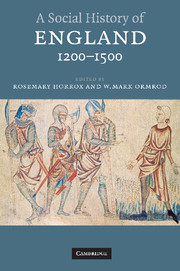Book contents
- Frontmatter
- Contents
- List of illustrations
- Preface
- List of contributors
- List of abbreviations
- 1 Introduction: Social structure and economic change in late medieval England
- 2 An age of deference
- 3 The enterprise of war
- 4 Order and law
- 5 Social mobility
- 6 Town life
- 7 The land
- 8 A consumer economy
- 9 Moving around
- 10 Work and leisure
- 11 Religious belief
- 12 A magic universe
- 13 Renunciation
- 14 Ritual constructions of society
- 15 Identities
- 16 Life and death: the ages of man
- 17 The wider world
- 18 Writing and reading
- 19 Conclusion
- Further reading
- Index
10 - Work and leisure
Published online by Cambridge University Press: 05 June 2012
- Frontmatter
- Contents
- List of illustrations
- Preface
- List of contributors
- List of abbreviations
- 1 Introduction: Social structure and economic change in late medieval England
- 2 An age of deference
- 3 The enterprise of war
- 4 Order and law
- 5 Social mobility
- 6 Town life
- 7 The land
- 8 A consumer economy
- 9 Moving around
- 10 Work and leisure
- 11 Religious belief
- 12 A magic universe
- 13 Renunciation
- 14 Ritual constructions of society
- 15 Identities
- 16 Life and death: the ages of man
- 17 The wider world
- 18 Writing and reading
- 19 Conclusion
- Further reading
- Index
Summary
The teaching of the Christian Church on work and leisure was distinctly ambivalent. On the one hand Adam and Eve, after eating the forbidden fruit, were doomed to a life of perpetual toil, Adam tilling the ground and Eve bearing children in pain. Yet labour was also a means of developing the spiritual life of an individual. With labour, a man could produce goods that enabled him to give rather than receive charity. The willing adoption of labour, as in the case of monks, served as a form of penance. Above all, not working rendered men and women spiritually vulnerable and prey to the devil. Discussion of the sin of acedia (sloth), from the time of its earliest interpretation by Cassian, included both the internal, psychological state of spiritual dryness and the behaviour that might flow from such a state – the failure to perform one's spiritual duties to God. Over time, however, the aspect of laziness in the religious life came to predominate. By the end of the middle ages what had started as a monastic and spiritual vice had become the plain laziness of Everyman. As part of this transformation, the state of not working (otiositas), which in the eighth century had been almost synonymous with acedia, came to mean both idleness and time spent on pleasurable activities known as leisure.
Both social class and gender affected the work that people did and the amount of time that they had for leisure.
- Type
- Chapter
- Information
- A Social History of England, 1200–1500 , pp. 276 - 292Publisher: Cambridge University PressPrint publication year: 2006
- 3
- Cited by



